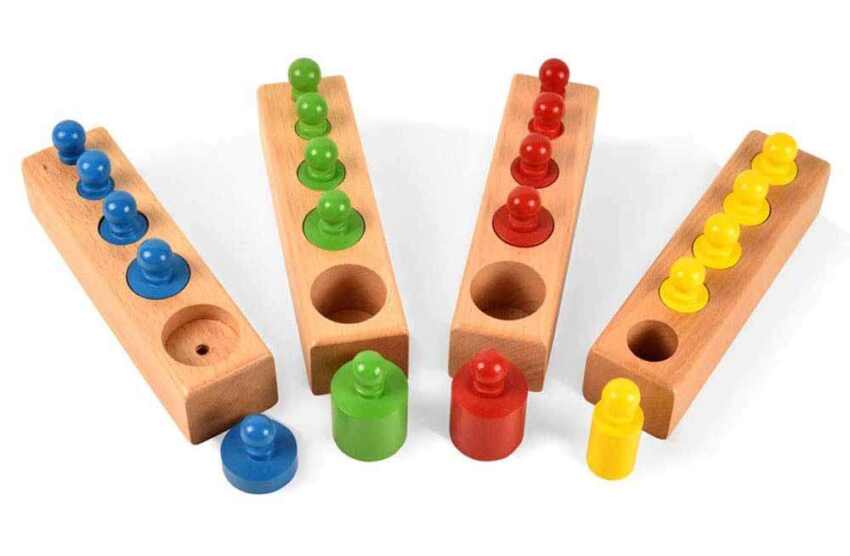Knobbed Cylinders
The Knobbed Cylinders are a Montessori Sensorial fabric, designed to help kids in making differences of their instant environment. This fabric by and large engages the senses of contact and sight. The fabric is made out of 10 distinctive cylinders with ‘knobs’ used to maintain every item the use of the pincer grip. Each cylinder suits into a particular hollow on a stable block of wood.
There are 4 distinctive versions of the Knobbed Cylinders, permitting kids to assignment distinctive perceptions of initial mathematical concepts, together with weight and size. Each Knobbed Cylinder block differs as follows:
- Block One: varies on peak and diameter, ie. the tallest cylinder additionally has the widest diameter.
- Block Two: variant is primarily based totally at the diameter of every hollow.
- Block Three: varies on peak and diameter, ie. the tallest cylinder additionally has the thinnest diameter.
- Block Four: variant is primarily based totally on the peak of the cylinders
Purpose
Children start running with the Knobbed Cylinders from the age of 3 years old. They are generally used to train youngsters to visually discriminate among dimensions; however, as competency grows, infant can start to distinguish with touch. This Montessori fabric additionally not directly prepares college students for writing, as they start coordinating their hands in a pincer grip, that’s used later for containing pencils. It additionally lays the muse for destiny paintings in arithmetic and language, as youngsters analyze phrases such as ‘height’ and ‘diameter’.
Presentation 1: Introducing the Knobbed Cylinder Block
- Invite the kid to return back paintings with you, and manual them to the Sensorial curriculum area.
- Identify the Knobbed Cylinders and select out up the fabric through gripping the block on each aspects with hands.
- Carry the fabric at waist height, parallel to the floor, on your paintings mat or desk area.
- Beginning at the most important cylinder, display the kid the way to take out every Knobbed Cylinder the use of their thumb and forefingers (the pincer grip), through grabbing the handle.
- Pause for a second as soon as the cylinder clears the hollow, to permit the kid to look the dimensions of the entire cylinder.
- Place this cylinder in the front of the timber block.
- Continue to get rid of every cylinder with inside the identical way, putting them so as in the front of the timber block.
- This is normally carried out from biggest to smallest. Once all cylinders were eliminated, select out up the primary cylinder that turned into eliminated from the timber block.
- Trace across the base of the cylinder the use of the index and center fingers. Using those identical finger, hint across the matching hollow at the timber block.
- Place the cylinder in the ideal hollow slowly, permitting the kid to observe your movements.
- Repeat with the alternative cylinders.
- Once all were replaced, provide the kid a turn, guiding them via the pastime as needed.
- Return the pastime to the sensorial cabinets as soon as entire, ensuring to hold the cylinder blocks with inside the identical way as getting them out.
Presentation 2: Becoming Familiar with the Cylinders
Once the kid can optimistically paintings via presentation one for every Knobbed Cylinder block, start to randomize the order of removing, placing, and setting again every cylinder. This permits the kid to emerge as acquainted with locating the cylinder with the right dimensions to fill every empty space.
Presentation 3 and Beyond
After the kid is cushty with presentation two, you could start to introduce a couple of Knobbed Cylinder block to the exercises. Begin with the ordered presentation one, earlier than conquering the randomization of presentation two.

